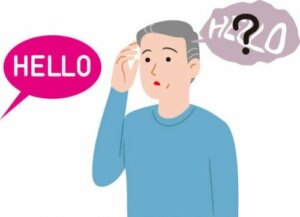Dysarthria: Causes, Symptoms, and Treatment

Communication disorders, such as stuttering, can have many different causes. In this article, we’re going to talk about dysarthria, a term you’ve most likely never heard of, which refers to a disease that affects the muscles that are used to articulate sounds.
Dysarthria has different causes and a symptomatology that’s important for you to know how to identify. In fact, the sooner this condition is diagnosed, the sooner you can start a treatment that allows you to address this disorder and improve it.
The causes of dysarthria
To explain the causes of dysarthria, we’re going to take the article “Dysarthrias” as a reference. It explains the different experiences that can cause the appearance of this disorder. We’re going to classify them as follows:
- Parkinson’s disease. Slow movements, as well as the tremors that appear when at rest, can cause monotonous articulation of sounds, decreased voice volume, and a lack of word accentuation.
- Brain injury. Trauma to the head can cause brain injury that, in turn, causes dysarthria with a nasal voice, a frequently interrupted articulation of words, or word accentuation disturbances.
- Other diseases. Degenerative diseases and brain tumors can cause distortions when pronouncing consonants, slow speech when talking to others, and difficulty speaking.

These are only some of the causes of dysarthria, as there are many more. In fact, a stroke, cerebral palsy, or Huntington’s disease can cause some of the symptoms we already mentioned but we’ll address that much more extensively below.
Read on to learn more: Early Detection of Alzheimer’s Through Speech
The most characteristic symptoms of dysarthria
In the previous section, we mentioned some of the symptoms of this condition. However, now we’re going to delve deeper into them, many of which are included in the article “Speech, language, and swallowing in Huntington’s disease”.
- Speaking in whispers. A person who suffers from this condition is unable to raise their voice and can’t speak in a normal tone.
- Nasal voice. Without being bunged up or having any other problem that prevents the passage of air through the nose, the person with this disorder tends to speak with a very evident nasal voice.
- Babbling. The sounds of the words are changed or even suppressed.
- Uneven or abnormal speech rhythm. A person who suffers from dysarthria can speak very quickly, making it very difficult to understand what they’re saying. But this can alternate between very slow speech.
- Monotone speech. Whether to ask questions or show surprise, the voice always maintains the same tone.
If a person is suffering from these symptoms, they’ll need to go see a doctor who, after carrying out the tests they deem appropriate, will determine whether they’re suffering from dysarthria. Once they diagnose this disorder, there are different ways to approach it.
This article may interest you: Language Delays in Children: Types, Symptoms, and Causes
Treatment for dysarthria

The treatments for dysarthria depend on the causes and what the doctor considers best for the patient’s satisfactory evolution. However, speech therapists play a very important role.
They work with various exercises to improve communication (breathing, phonation, prosody, relaxation, etc.), helping to reduce babble, correct the rhythm as much as possible, and reduce monotone when communicating.
Also, psychologists usually intervene, as patients with dysarthria can become isolated and suffer depression due to the symptoms they suffer from. If the condition is severe, it may require surgical intervention.
In short, we hope that this article helped you discover this not very common communication disorder. Also, if you have any of the symptoms we mentioned above, don’t hesitate to go see your trusted doctor.
All cited sources were thoroughly reviewed by our team to ensure their quality, reliability, currency, and validity. The bibliography of this article was considered reliable and of academic or scientific accuracy.
- Hernández Jaramillo, Janeth, & Uribe Granja, Manuel Guillermo. (2011). LOS DESÓRDENES DEL LENGUAJE: DE LAS NEUROCIENCIAS A LA NEURO-REHABILITACIÓN. Revista de la Facultad de Medicina, 59(1), 56-67. Retrieved April 26, 2019, from http://www.scielo.org.co/scielo.php?script=sci_arttext&pid=S0120-00112011000100007&lng=en&tlng=es.
- Marín Venegas, A., Sepúlveda Garrido, C., & Bello Mesina, F. (2017). Terapias para el tratamiento de la disartria en niños con parálisis cerebral: una revisión sistemática. Rehabil. integral (Impr.), 12(2), 66-74.
- Mateo-Sierra, O., Gutiérrez, F.A., Fernández-Carballal, C., Pinilla, D., Mosqueira, B., Iza, B., & Carrillo, R.. (2005). Mutismo acinético relacionado con hidrocefalia y cirugía cerebelosa tratado con bromocriptina y efedrina: revisión fisiopatológica. Neurocirugía, 16(2), 134-141. Recuperado en 26 de abril de 2019, de http://scielo.isciii.es/scielo.php?script=sci_arttext&pid=S1130-14732005000200005&lng=es&tlng=es.
- Rodrigo Agudo, J. L., Valdés Mas, M., Vargas Acosta, A. M., Ortiz Sánchez, M. L., Gil del Castillo, M. L., Carballo Álvarez, L. F., & Pons Miñano, J. A.. (2008). Presentación clínica, diagnóstico y evolución a largo plazo en 29 pacientes con enfermedad de Wilson. Revista Española de Enfermedades Digestivas, 100(8), 456-461. Recuperado en 26 de abril de 2019, de http://scielo.isciii.es/scielo.php?script=sci_arttext&pid=S1130-01082008000800002&lng=es&tlng=es.
This text is provided for informational purposes only and does not replace consultation with a professional. If in doubt, consult your specialist.








